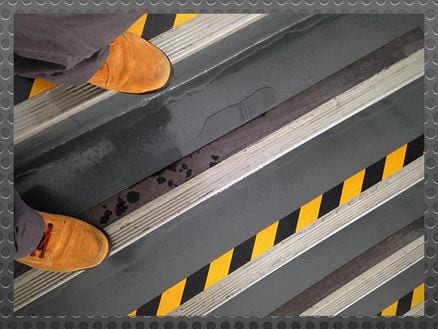- About Us
- Our Services
- Training Expertise
- Crisis Management for Business & Industry
- DOT PHMSA ALERT Rail Car Training
- Emergency Management
- Environmental & HAZMAT
- First Response & HAZWOPER
- Maritime Security
- OSHA Training/Confined Space
- RDPC
- Safer News Gathering
- Safer Ohio Schools Using Threat Assessment Management
- School Safety & Security
- Workplace Violence Prevention
- Courses
- Our Clients
- Media
Preventing Falls By Rule And Ritual, Part One

This week on Tuesday Training, we start a two-part look at recent regulatory changes regarding workplace fall protection. The latest version of OSHA regulations in this area started to go into effect at the start of 2017. The new regs are intended to improve walking-working surfaces and establish a new fall protection standard. Some requirements came to bear at different dates throughout this year. The last of these become effective in mid-November, so now may be a great time to review your company’s compliance status.
No matter the efforts to prevent it, people still fall on the job.
The second-leading cause of US lost work time injuries and deaths is now falls, both at the same level and to lower levels. There are almost 6,000 injuries in this category each year, and about 30 deaths. At Findlay All Hazards, we believe that many of these are attributable to a casual attitude toward common workplace circumstances, and a misunderstanding of what “fall protection” actually includes.
Reducing the accident stats in this category cannot be fully accomplished by changes in regulations. Only a sharpening of safety skills and the development of an always-alert mindset can protect a worker, even in the most common situations. Many people travel the very same footpaths every day. As they do so, their rate of travel increases each day and their thoughts drift to other matters as they make these trips. That’s only natural. We subconsciously think, “What wasn’t there yesterday, or the 100 days before, won’t be there today.” But it’s not the truth. Any industrial pathway, whether at ground level or not, is subject to a myriad of potential changes, day-to-day. Changes in temperature and humidity can make more of a difference on walkways or ladders than many might expect. The route might very well include a new obstacle, without that being announced. Just the act of looking up a fixed ladder before ascending is often forgotten, only because the route is so common to the employee using the ladder.
Warning and reminder signs do have a positive effect, but not as much as mental reinforcement of simple safety values and learning safety rituals, such as:
Consistently consider your walking pace. Almost every time a person travels a familiar route and asks themselves, “Am I unsafely hurrying?”, the answer is yes.
• Slow down at corners, as you would when driving a car, and look each way before turning the corner.
• Inspect a ladder, scaffold, or stairwell every time you use it, especially if any of these are exposed to the elements. ‘Inspecting’ a flight of stairs before climbing it may seem like a chore – we all seem to climb stairs each day, over and over. But in this case, it’s as easy as giving a glance to assure that no one (and nothing) is beneath or above you before you climb or descend. That act takes less than a second. Your first touch of any ladder or handrail should be a lingering one… Is the rung you touch wet, or colder or warmer than usual? If so, extra precaution is certainly needed, or another route may be in order.
• Many, many doors that open into walkway paths have no windows. Anyone on the other side of the door when it opens with force could be knocked down. It should be mandatory practice to open such doors slowly and with an announcement, such as a knock that precedes opening the door by at least a second.
• Develop a mental checklist for the trail you leave behind as you walk. For example, if you opened a hatch to ascend through it, should it be closed behind you? Returning by the same path to find an open hatch in a floor or a vessel could result in catastrophe if you carelessly step into a hole where there should be a closed hatch.
All of those points are a form of fall protection, as likely to prevent accidents as lanyards and harnesses.
When we discuss careful use of walkways and fall protection, we typically picture a safety-helmeted technician traversing a complex workplace. But walkway safety is hardly limited to such environments. If someone carries a large box from office to office, with restricted vision thanks to the size of the object, they are in danger of tripping over an unseen object near floor level. Accidents like that can certainly result in lost time, and greater injury than one might imagine. And all it would take to prevent the mishap might have been moving the contents of the box in two loads versus one.
The common terms we’ve used today – ladder, scaffold, walkway, etc. – are all examined in the updated OSHA regulations, and we’ll look at those in next week’s Tuesday Training.
Meantime, ask yourself if the simple safe walking and climbing reminders we’ve listed this week are part of your team’s mindset. Does everyone move in a safe manner 100% of the time? If not, an accident is not just possible, it’s certain.
